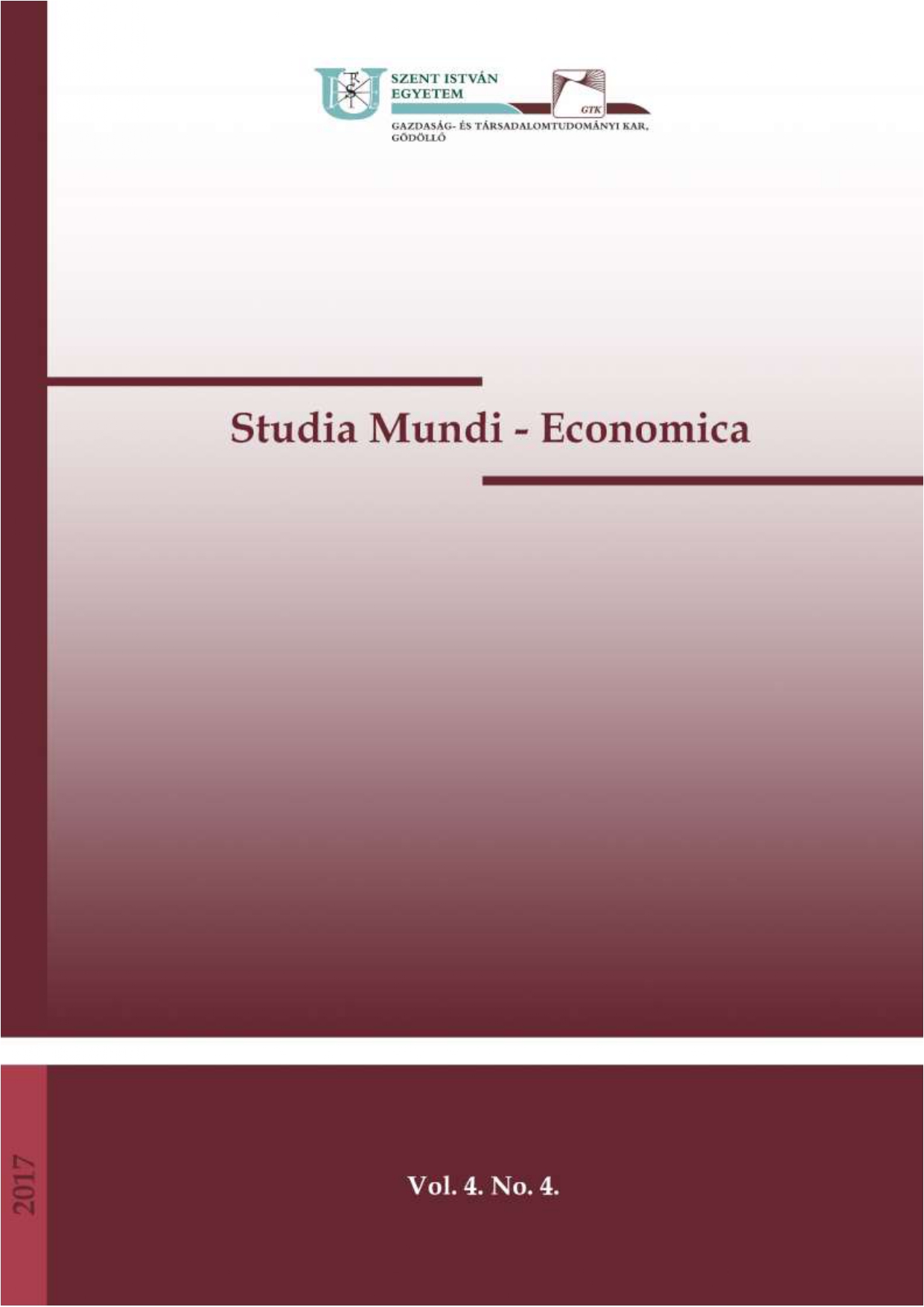A hungarikumok szerepe a vidékfejlesztésben Bátya példáján keresztül
DOI:
https://doi.org/10.18531/Studia.Mundi.2017.04.04.69-82Kulcsszavak:
endogén erőforrások, élelmiszer, hungarikumok, versenyképesség, vidékfejlesztésAbsztrakt
A hungarikumok mint endogén erőforrások szerepét a terület- és vidékfejlesztésben régóta hangsúlyozza a szakirodalom. Egy falukutató tábor keretén belül kifejezetten egy mezőgazdasági terméknek mint endogén erőforrásnak a szerepét vizsgáltuk egy vidéki település, a Kalocsa melletti Bátya esetében, különös tekintettel a foglalkoztatásra, illetve a helyi termék-előállításra. A falu történetében a fűszerpaprika-termesztés kiemelkedő. A primer kutatás eredményei alapján, a mezőgazdaság foglalkoztatási szerepkörének általános visszaesése mellett, a paprikatermesztés ugyan még mindig kimutatható hatással van a település életére, és potenciállal rendelkezik a helyi fejlesztések tekintetében, ugyanakkor az ágazatot érintő problémáknak köszönhetően kérdéses, hogy ezt az endogén tényezőt mennyi ideig tudja megőrizni Bátya.
Hivatkozások
Áldorfai Gy. - Czabadai L.(2014): Helyi válaszok a globális kihívásokra. Acta Carolus Robertus 4 (2), pp. 9-18.
Áldorfai Gy. - Topa Z. - Káposzta J. (2015): The planning of the Hungarian local development strategies by using CLLD approach. Acta Avada (2), pp. 13-22
Bakos I. M. - Topa Z. (2016): The Contribution of Local Food to Tourism in Hungary. Contemporary Research On Organization Management And Administration 4 (2), pp. 63-74.
Belletti et al. (2003). Paths of rural development based on typical products: a comparison between alternative strategies. In: Cristovao A. - Omodei Z. L. (Eds.): Farming and rural systems research and extension - Local identities and globalisation. Fifth IFSA European Symposium Florence. Firenze: ARSIA, pp.384-395.
Cernea M. (1992) The Building Blocks of Participation. Washington: World Bank
Chesire, P. C. (2003): Territorial competition: lessons for (innovation) policy. In: Bröcker J. - Dohse, D. - Soltwedel, R (Eds.): Innovation clusters and interregional competition. Heidelberg: Springer, pp. 331-346.
EC (1999): Sixth Periodic Report on the Social and Economic Situation and Development of Regions in the European Union. European Commission: Luxembourg
EC (2005): 1698/2005/EK - A Tanács rendelete (2005. szeptember 20.) az Európai Mezőgazdasági Vidékfejlesztési Alapból nyújtandó vidékfejlesztési támogatásról. OJ L 277 (2005. 10. 21). Európai Közösségek, Luxemburg
Endrighi E. (1999): La valorizzazione delle produzioni tipiche locali. Dal concetto di valore alle indicazioni operative. (The valorisation of typical local products. From the concept of value to the operative indications). Rivista di Economia Agraria LIV (1), pp. 3-26.
Fehér Z. (2013): „Sürgősen eladó háromszáz négyszögöl termőföld…”. Egy sárközi kertészkedő falu népének és földjének helyzete a téeszvilág után. Hitel 26 (2), pp. 195- 221.
Horváth Gy. (Szerk.) (2006): Régiók és települések versenyképessége. Pécs: MTA RKK
Káposzta J. (2007): Regionális gazdaságtan. Gödöllő: SZIE GTK
Kassai, Zs. - Káposzta, J. - Ritter, K. - Dávid, L. - Nagy, H. - Farkas, T. (2016): The territorial significance of food hungaricums: the case of pálinka. Romanian Journal Of Regional Science 10 (2), pp. 64-84.
Kopasz M. (2005): Multifuncionális mezőgazdaság az EU törekvéseinek összhangjában. A Falu (1), pp. 51-60.
Kulcsár L. (szerk.) (2006): Vidékfejlesztés. Gödöllő: SZIE
Lengyel I. (2003): Verseny és területi fejlődés: térségek versenyképessége Magyarországon. Szeged: JATEPress
Lengyel M. (1992): A turizmus általános elmélete. Budapest: Viva Kft
Lowe P. - Murdoch J. - Ward N. (1995): Networks in Rural Development: beyond exogenous and endogenous models. In: Ploeg J. D. van der - Dijk G. van (Ed.): Beyond modernisation: The impact of endogenous rural development Assen: Van Gorcum. 87-105. p.
Lukovics M. - Kovács P. (2008): Eljárás a területi versenyképesség mérésére. Területi Statisztika (3) 245-263. p.
Madarász I. (2004): A vidék funkciói az Európai Unióban. A Falu (4), pp. 35-43.
Michalkó G. (2004): A turizmuselmélet alapjai. Székesfehérvár: Kodolányi János Főiskola
Moseley, M. J. (2003): Rural Development Principles and Practice. London: Sage
Murdoch J. (1995): Sustainable Rural Development: Towards a research agenda.
Regional Studies (5), pp. 479-499.
Nagy A. - Virág Á. (2014): Destination management in Hungary. Vestnik Apk Stavropolya / Agricultural Bulletin Of Stavropol Region 1 (1), pp. 41-44.
Nagy H. - Tóth T. - Oláh I. (2012): The role of local markets in the sustainable economic development of Hungarian rural areas. Visegrad Journal On Bioeconomy And Sustainable Development 1 (1), pp. 27-31.
Pacciani A. et al. (2001): The role of typical products in fostering rural development and the effects of regulation (EEC) 2081/92. http://www.origin-food.org/pdf/partners/belmarscaparole.pdf
Ploeg, J. D. van der - Dijk, G. van (szerk.) (1995): Beyond Modernization: The Impact of Endogenous Rural Development. Assen, The Netherlands: Van Gorcum
Puczkó L. - Rátz T. (2011): Az attrakciótól az élményig - A látogatómenedzsment módszerei. Budapest: Akadémia Kiadó
Ritter, K. - Virág, Á. (2015): Hungaricums - the role of endogenous resources in rural development through the example of Tokaj wine region. In: Jedynak, W. - Kinal, J. (Ed.): Selected aspects of socio-economical changes in a post-modern society. Rzeszów: University of Rzeszów. 7-16. p.
Tóth T. - Káposzta J. (szerk.)(2014): Tervezési módszerek és eljárások a vidékfejlesztésben (elmélet) Gödöllő: Szent István Egyetemi Kiadó
Tózsa I. - Zátori A. (2013): Hungarikumok. [Corvinus Turizmus Kompetencia Központ Szakkönyvsorozat - 1.] Budapest: Budapesti Corvinus Egyetem GK KTI Turizmus Kompetencia Központ
Török Á. (2013): Hungarikumok - Magyarország földrajzi árujelzői? Az eredetvédelem szerepe a XXI. századi mezőgazdaságban és élelmiszertermelésben - a pálinka példájának tanulságai. PhD értekezés. Budapest: Corvinus Egyetem
Letöltések
Megjelent
Folyóirat szám
Rovat
License
Copyright (c) 2017 Ritter Krisztián

This work is licensed under a Creative Commons Attribution-NonCommercial-NoDerivatives 4.0 International License.
A folyóirat Open Access (Gold). Cikkeire a Creative Commons 4.0 standard licenc alábbi típusa vonatkozik: CC-BY-NC-ND-4.0. Ennek értelmében a mű szabadon másolható, terjeszthető, bemutatható és előadható, azonban nem használható fel kereskedelmi célokra (NC), továbbá nem módosítható és nem készíthető belőle átdolgozás, származékos mű (ND). A licenc alapján a szerző vagy a jogosult által meghatározott módon fel kell tüntetni a szerző nevét és a szerzői mű címét (BY).






